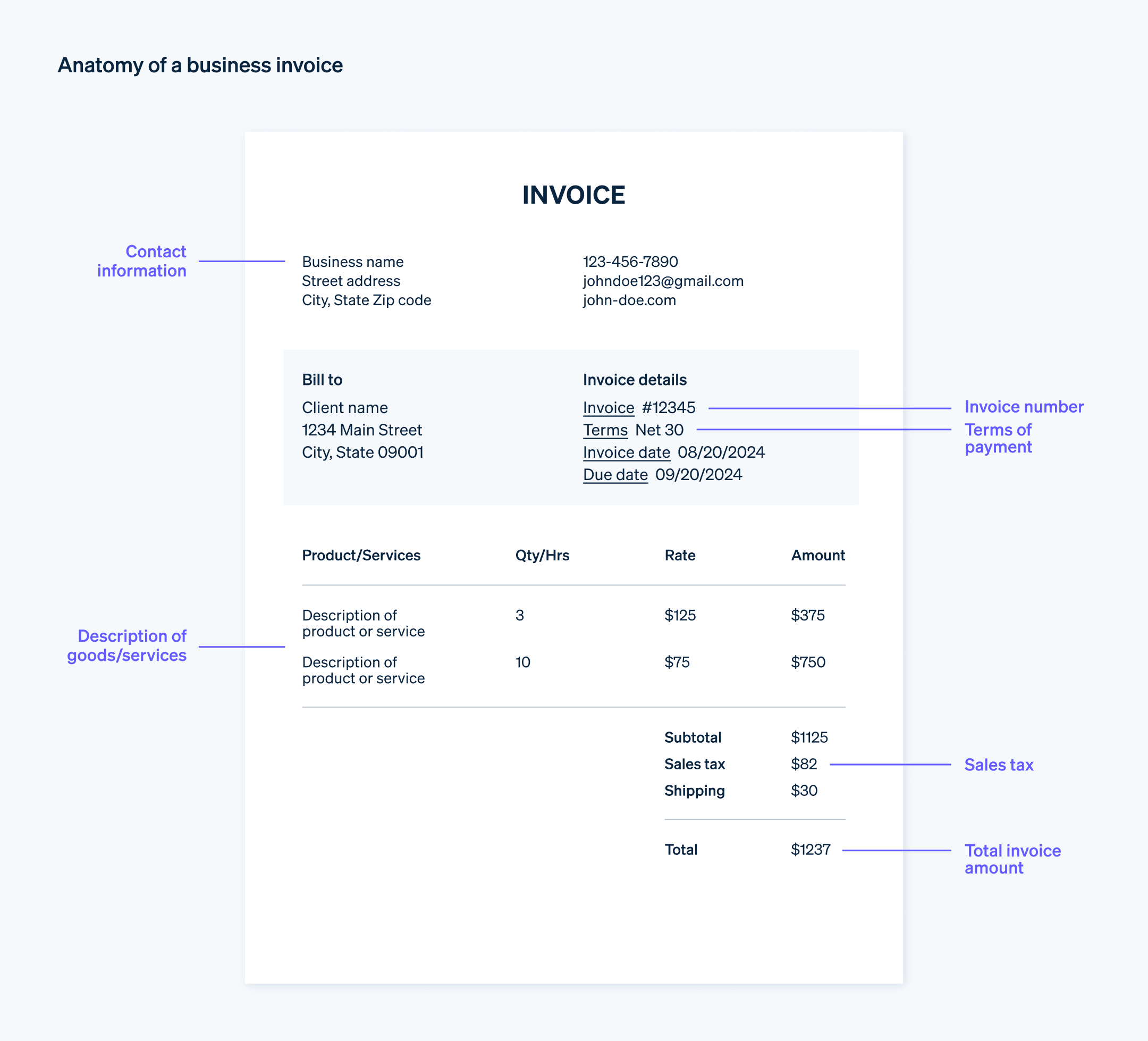了解发票要求有助于推动高效的现金流,并为所有企业建立透明的客户关系。
发票不仅仅是付款请求。它们是法律文件、销售历史记录,也是您财务工作流程的重要组成部分。通过完善您的发票开具流程并了解发票应包含的内容,您的企业可以避免因发票不清晰或不完整而造成的常见隐患,如延迟付款或有争议的费用。
我们将介绍企业在发票中应包含的重要内容,帮助您简化业务流程,提高利润。
目录
- 什么是发票?
- 发票的用途是什么?
- 发票要求:发票上应包含的内容
- 发票最佳实践:如何开具发票
- 坚持严格发票开具规范的好处
什么是发票?
发票 是企业发送给客户的正式文件。它作为企业提供的商品或服务的记录,包括客户有义务支付的计算总额。交易内容可以是产品、服务或两者的组合。
发票既是销售单据、收据,也是交易的法律和财务证明。发票是业务中不可或缺的一部分,是销售和付款流程 的关键组成部分。
发票的用途是什么?
发票的主要用途是提供双方交易的详细账目,确定客户支付应付金额的义务。它还便于双方准确记账,改善财务管理并提高透明度。发票对企业起着许多重要作用:
付款请求
发票是客户付款 的正式请求。它概述了企业提供的商品或服务的应付金额,从而推进了付款流程。收入跟踪
发票是跟踪销售和收入的重要工具。它们提供按时间顺序排列的业务交易记录,从而更容易监控一段时间内的销售情况、识别季节性趋势以及评估特定产品或服务的绩效。财务管理
准确及时地开具发票是管理公司现金流的必要条件。通过及时开具发票和跟进未付款项,企业可以保持健康的流动资金水平。记录保存
发票是销售的正式记录。它们有助于企业跟踪库存、监控客户购买习惯和管理账户余额。税务目的
发票是企业报税的核心部分。它们为计算收入、申请减税和证实纳税申报单上的支出提供了必要的文件。法律保护
在发生争议或审计时,发票也可以作为法律文件。它们提供详细的交易账目,可用于解决付款分歧或在审计期间核实财务活动。客户沟通
企业经常使用发票与客户沟通。它们可用于传递有关付款条件、联系方式的信息,甚至用于追加销售或交叉推广其他产品或服务。
发票要求:发票上应包含的内容
有效的发票 满足法律要求的特定要素,便于客户理解和付款。以下是企业应在发票上包含的主要内容:

标题
使“发票”一词在文档顶部清晰醒目,以便快速识别。企业信息
包括公司名称、营业地址、联系方式(如电话号码或电子邮件)以及任何其他相关信息。如果您有公司徽标,请以专业的方式展示。客户的业务信息
与您的业务信息类似,您也需要包含您要结算的客户或企业的名称、地址和联系方式。发票编号
为每张发票分配独一无二的标识号。这有助于双方在将来发生争议时参考交易。发票日期
说明发票日期,即开具发票的日期。它是管理付款时间表和了解现金流的重要组成部分。付款条件
明确说明付款条件。这可能包括付款到期日、任何提前付款奖励、逾期付款罚款以及您接受的支付方式。逐项列出商品或服务
详细说明向客户收取的费用。单独列出每个项目或服务,以及该明细项的描述、数量或小时数、费率和总金额。小计
计算并列出小计,即扣除任何税费或额外费用之前应付的总金额。它是所有行项目金额的总和。税费、费用和折扣
如果适用,请列出任何销售税、增值税、运费或折扣。每项应单独列出,并与小计相加或相减。应付总金额
列出应付总金额。这是在小计中加上税费并减去任何折扣后,客户欠您的最终金额。备注
您可以使用此可选部分提供其他信息,如感谢信、提醒事项或与交易相关的其他信息。
通过包含这些元素,您的发票将符合专业标准,并为您的客户提供及时准确地向您付款所需的所有信息。它还能确保您拥有所有交易的详细记录,以便日后参考、记账、报税和满足任何潜在的法律需求。
发票最佳实践:如何开具发票
开具有效的发票不仅仅是简单地添加所需的元素。以下是创建发票时需要考虑的一些最佳实践:
简洁明了:发票的每个组成部分都应该简单易懂。含糊不清会导致付款延迟,因此应尽可能清楚地说明每项收费的用途。
使用专业格式:发票不仅要实用,还要专业。这体现了您企业的信誉。一致的间距、可读的字体和逻辑布局都有助于提高发票的整体有效性。
使用唯一的发票编号:每张发票都应该有唯一的编号,以便于跟踪。一种常见的做法是使用序列号,或者您可以合并日期或客户代码。
设定明确的付款期限:指定付款的到期时间(例如,收到时、30 天、60 天等)和接受的支付方式。您为客户提供的服务越方便,您获得付款的速度就越快。
逐项列出服务或产品:将每项服务或产品单独列出,可以让客户更容易了解他们要支付的费用,也不容易让他们对收费提出异议。
正确应用税费和折扣:如果适用,请仔细计算税费、费用和折扣,并从小计里加减,以确定应付总额。
礼貌待人:礼尚往来能起到事半功倍的效果。给客户写一封简短的感谢信或留言。这样的礼貌举动可以促进良好的关系,并有可能加快付款速度。
及时发送:提供商品或服务后,请尽快发送发票。发票发送得越快,您就有可能越早收到付款。
跟进:如果在到期日之前未收到付款,请进行友好提醒。这可以通过电子邮件、电话或其他提醒发票来完成。
保留副本:最好保留所有发票的副本。这对于财务管理、税务目的以及任何交易纠纷都很有用。
坚持严格发票开具规范的好处
发票实践是业务运营的重要组成部分。它们有助于公司的财务健康和成功的客户关系。坚持严格发票开具规范有很多好处:
改善现金流管理
良好的发票开具方式可直接增加现金流,这对任何企业都很重要。通过及时开具发票并明确付款条件,企业可望加快付款周转速度,减少商品或服务支出与收入之间的差距。这可确保企业有必要的资金来支付运营成本、支付员工工资以及投资库存或资源。它还能减少对信用额度或贷款的需求,从而节省利息,提高财务稳定性。提高客户满意度
清晰、准确和专业的发票做法可以提高客户满意度。包括成本、税费和应付总金额的详细明细,以及多种付款方式,以增加便利性。向客户提供处理付款所需的所有信息表明尊重他们的时间和金钱,并增强他们对公司的信任,从而带来回头客和推荐。满意的客户更有可能及时付款,这进一步改善了现金流,并减轻了跟进逾期付款的行政负担。提升专业形象
在商业世界中,细节很重要。发票的设计、清晰度和准确性反映了您的整体业务。客户会将一张精心制作的发票视为一个运营良好的组织的标志,从而强化您的专业形象。这可以增强客户对您业务的信心,并为您的交易设定一个高标准。而包含您的品牌(徽标、品牌颜色、企业名称等)的统一发票格式有助于提升您的品牌形象和知名度。促进及时付款
清晰全面的发票可以减少客户误解或疑问的可能性,这通常是付款延迟的原因。通过指定付款条件、到期日和接受的付款方式,您可以对预期的付款时间和方式设定明确的期望。销售后及时开具发票,以及礼貌地提醒逾期付款,还可以鼓励您的客户优先结清会费。管理您的财务记录
精心准备的发票是您销售的重要记录。唯一的发票编号可帮助您轻松查询和跟踪交易。商品或服务的详细明细可以更好地监督您的收入流,帮助您确定哪些产品或服务最有利可图。此外,保留所有发票的副本可以简化簿记,从而更容易跟踪收入、核对账目以及准备财务报表或纳税申报表。
要详细了解 Stripe Invoicing 如何帮助您减少企业的开具发票工作量,请点击此处。
本文中的内容仅供一般信息和教育目的,不应被解释为法律或税务建议。Stripe 不保证或担保文章中信息的准确性、完整性、充分性或时效性。您应该寻求在您的司法管辖区获得执业许可的合格律师或会计师的建议,以就您的特定情况提供建议。